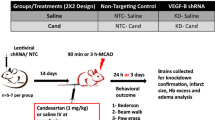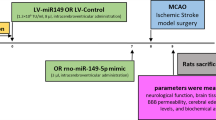Abstract
Research into stroke is driven by frustration over the limited available therapeutics. Targeting a single aspect of this multifactorial disease contributes to the therapeutic boundaries. To overcome this, we devised a novel multifactorial-cocktail treatment, using lentiviruses encoding excitatory amino acid transporter 2 (EAAT2(, glutamate dehydrogenase 2 (GDH2), and nuclear factor E2-related factor 2 (Nrf2) genes, that acts synergistically to address the effected excito-oxidative axis. Here, we used the vasoconstrictor endothelin-1 (ET-1) to induce focal ischemic injury in mice by direct injection into the striatum. Mice treated with the mixture of these three genes show significant improvement in body balance, motor coordination, and decreased motor asymmetry compared to each gene separately. These results demonstrate that overexpression of the combined EAAT2, GDH2, and NRF2 genes can provide neuroprotection after ischemic injury.




Similar content being viewed by others
References
Anderson CS, Linto J, Stewart-Wynne EG (1995) A population-based assessment of the impact and burden of caregiving for long-term stroke survivors. Stroke 26:843–849
Anderson MF, Blomstrand F, Blomstrand C, Eriksson PS, Nilsson M (2003) Astrocytes and stroke: networking for survival? Neurochem Res 28:293–305
Barone FC, Feuerstein GZ (1999) Inflammatory mediators and stroke: new opportunities for novel therapeutics. J Cereb Blood Flow Metab 19:819–834
Begum G, Song S, Wang S, Zhao H, Bhuiyan MIH, Li E, Nepomuceno R, Ye Q, Sun M, Calderon MJ, Stolz DB, St. Croix C, Watkins SC, Chen Y, He P, Shull GE, Sun D (2018) Selective knockout of astrocytic Na1/H1 exchanger isoform 1 reduces astrogliosis, BBB damage, infarction, and improves neurological function after ischemic stroke. Glia 66:126–144
Benkler C, Barhum Y, Ben-Zur T, Offen D (2016) Multifactorial gene therapy enhancing the glutamate uptake system and reducing oxidative stress delays symptom onset and prolongs survival in the SOD1-G93A ALS mouse model. J Mol Neurosci 58:46–58
Chamorro Á, Dirnagl U, Urra X, Planas AM (2016) Neuroprotection in acute stroke: targeting excitotoxicity, oxidative and nitrosative stress, and inflammation. Lancet Neurol 15:869–881
Chaudhry FA, Lehre KP, van Lookeren et al (1995) Glutamate transporters in glial plasma membranes: highly differentiated localizations revealed by quantitative ultrastructural immunocytochemistry. Neuron 15:711–720
Choi K, Kim J, Kim GW, Choi C (2009) Oxidative stress-induced necrotic cell death via mitochondria-dependent burst of reactive oxygen species. Curr Neurovasc Res 6:213–322
Chu K, Lee ST, Sinn DI (2007) Pharmacological induction of ischemic tolerance by glutamate transporter-1 (EAAT2) upregulation. Stroke 38:177–182
Cuzzocrea S, Riley DP, Caputi AP, Salvemini D (2001) Antioxidant therapy: a new pharmacological approach in shock, inflammation, and ischemia/reperfusion injury. Pharmacol Rev 53:135–159
Dirnagl U, Iadecola C, Moskowitz MA (1999a) Pathobiology of ischaemic stroke: an integrated view. Trends Neurosci 22:391–397
Dirnagl U, Iadecola C, Moskowitz M (1999b) Pathobiology of ischaemic stroke: an integrated view. 4441. Trends Neurosci 22:391–397
Donnan GA, Davis SM (2008) Neuroprotection: still achievable in humans. Stroke 39:525–530
Fuxe K, Cintra A, Andbjer B (1989) Centrally administered endothelin-1 produces lesions in the brain of the male rat. Acta Physiol Scand 137:155–156
Glat MJ, Benninger F, Barhum Y, Ben-Zur T, Kogan E, Steiner I, Yaffe D, Offen D (2016) Ectopic muscle expression of neurotrophic factors improves recovery after nerve injury. J Mol Neurosci 58(1):39–45
Han B, Haley WE (1999) Family caregiving for patients with stroke: review and analysis. Stroke 30:1478–1485
Harvey BK, Airavaara M, Hinzman J, Wires EM, Chiocco MJ, Howard DB, Shen H, Gerhardt G, Hoffer BJ, Wang Y (2011) Targeted over-expression of glutamate transporter 1 (GLT-1) reduces ischemic brain injury in a rat model of stroke. PLoS One 6(8). https://doi.org/10.1371/journal.pone.0022135
Horie N, Maag AL, Hamilton SA, Shichinohe H, Bliss TM, Steinberg GK (2008) Mouse model of focal cerebral ischemia using endothelin-1. J Neurosci Methods 173:286–290
Hudson RC, Daniel RM (1993) L-glutamate dehydrogenases: distribution, properties and mechanism. Comparative Biochemistry and Physiology. B, Comparative Biochemistry 106:767–792
Ishii T, Itoh K, Takahashi S, Sato H, Yanagawa T, Katoh Y, Bannai S, Yamamoto M (2000) Transcription factor Nrf2 coordinately regulates a group of oxidative stress-inducible genes in macrophages. J Biol Chem 275:16023–16029
Itoh K, Chiba T, Takahashi S, Ishii T, Igarashi K, Katoh Y, Oyake T, Hayashi N, Satoh K, Hatayama I, Yamamoto M, Nabeshima Y (1997) An Nrf2/small Maf heterodimer mediates the induction of phase II detoxifying enzyme genes through antioxidant response elements. Biochem Biophys Res Commun 236(2):313–322
Kurosawa M, Fuxe K, Hallström A, Goiny M, Cintra A, Ungerstedt U (1991) Responses of blood flow, extracellular lactate, and dopamine in the striatum to intrastriatal injection of endothelin-1 in anesthetized rats. J Cardiovasc Pharmacol 17:S340–S342
Lai TW, Zhang S, Wang YT (2014) Excitotoxicity and stroke: identifying novel targets for neuroprotection. Prog Neurobiol 115:157–188
Lakhan SE, Kirchgessner A, Hofer M (2009a) Inflammatory mechanisms in ischemic stroke: therapeutic approaches. J Transl Med 7:97–102
Lakhan SE, Kirchgessner A, Hofer M (2009b) Inflammatory mechanisms in ischemic stroke: therapeutic approaches. J Transl Med 7:97–103
Laterza C, Wattananit S, Uoshima N, Ge R, Pekny R, Tornero D, Monni E, Lindvall O, Kokaia Z (2017) Monocyte depletion early after stroke promotes neurogenesis from endogenous neural stem cells in the adult brain. Exp Neurol 297:129–137
Li M, Li Z, Yao Y, Jin WN, Wood K, Liu Q, Shi FD, Hao J (2017) Astrocyte-derived interleukin-15 exacerbates ischemic brain injury via propagation of cellular immunity. Proc Natl Acad Sci U S A 114:E396–E405
Lin CL, Kong Q, Cuny GD, Glicksman MA (2012) Glutamate transporter EAAT2: a new target for the treatment of neurodegenerative diseases. Future Med Chem 4:1689–1700
Lo EH, Dalkara T, Moskowitz MA (2003) Neurological diseases: mechanisms, challenges and opportunities in stroke. Nat Rev Neurosci 4:399–414
Matsui T, Mori T, Tateishi N, Kagamiishi Y, Satoh S, Katsube N, Morikawa E, Morimoto T, Ikuta F, Asano T (2002) Astrocytic activation and delayed infarct expansion after permanent focal ischemia in rats. Part I: enhanced astrocytic synthesis of S-100?? In the periinfarct area precedes delayed infarct expansion. J Cereb Blood Flow Metab 22:711–722
Muir KW, Tyrrell P, Sattar N, Warburton E (2007) Inflammation and ischaemic stroke. Curr Opin Neurol 20:334–342
Murphy S (2000) Production of nitric oxide by glial cells: regulation and potential roles in the CNS. Glia 29:1–13
Nguemeni C, Gomez-Smith M, Jeffers MS, Schuch CP, Corbett D (2015) Time course of neuronal death following endothelin-1 induced focal ischemia in rats. J Neurosci Methods 242:72–76
Nguyen T, Nioi P, Picket CB (2009) The Nrf2-antioxidant response element signaling pathway and its activation by oxidative stress. J Biol Chem 284:13291–13295
Plaitakis A, Metaxari M, Shashidharan P (2000) Nerve tissue-specific (GLUD 2) and housekeeping (GLUD 1) human glutamate dehydrogenases are regulated by distinct allosteric mechanisms : implications for biologic function. J Neurochem 75(5):1862–1869
Plaitakis A, Metaxari M, Shashidharan P (2010) Gain-of-function variant in GLUD2 glutamate dehydrogenase modifies Parkinson’s disease onset. Eur J Hum Genet 18:336–341
Rao VL, Dogan A, Bowen KK, Todd KG, Dempsey RJ (2001) Antisense knockdown of the glial glutamate transporter GLT-1 exacerbates hippocampal neuronal damage following traumatic injury to rat brain. Eur J Neurosci 13:119–128
Rothstein JD, Dykes-Hoberg M, Pardo CA, Bristol LA, Jin L, Kuncl RW, Kanai Y, Hediger MA, Wang Y, Schielke JP, Welty DF (1996) Knockout of glutamate transporters reveals a major role for astroglial transport in excitotoxicity and clearance of glutamate. Neuron 16:675–686
Schallert T, Fleming SM, Leasure JL, Tillerson JL, Bland ST (2000) CNS plasticity and assessment of forelimb sensorimotor outcome in unilateral rat models of stroke, cortical ablation, parkinsonism and spinal cord injury. Neuropharmacology 39:777–787
Shashidharan P, Clarke DD, Ahmed N, Moschonas N, Plaitakis A (1997) Nerve tissue-specific human glutamate dehydrogenase that is thermolabile and highly regulated by ADP. J Neurochem 68:1804–1811
Shih AY, Li P, Murphy TH (2005) A small-molecule-inducible Nrf2-mediated antioxidant response provides effective prophylaxis against cerebral ischemia in vivo. J Neurosci 25:10321–10335
Stineman MG, Maislin G, Fiedler RC, Granger CV (1997) A prediction model for functional recovery in stroke. Stroke 28:550–556
Surh YJ, Kundu JK, Na HK (2008) Nrf2 as a master redox switch in turning on the cellular signaling involved in the induction of cytoprotective genes by some chemopreventive phytochemicals. Planta Med 74(13):1526–1539
Takagi T, Kitashoji A, Iwawaki T, Tsuruma K, Shimazawa M, Yoshimura S, Iwama T, Hara H (2014) Temporal activation of Nrf2 in the penumbra and Nrf2 activator-mediated neuroprotection in ischemia-reperfusion injury. Free Radic Biol Med 72:124–133
Takahashi K, Foster JB, Lin C (2015) Glutamate transporter EAAT2: regulation, function, and potential as a therapeutic target for neurological and psychiatric disease. Cell Mol Life Sci 72:3489–3506
Wang Q, Tang XN, Yenari MA (2007) The inflammatory response in stroke. J Neuroimmunol 184:53–68
Weller ML, Stone IM, Goss A, Rau T, Rova C, Poulsen DJ (2008) Selective overexpression of excitatory amino acid transporter 2 (EAAT2) in astrocytes enhances neuroprotection from moderate but not severe hypoxia-ischemia. Neuroscience 155(4):1204–1211
Yamauchi K, Nakano Y, Imai T, Takagi T, Tsuruma K, Shimazawa M, Iwama T, Hara H (2016) A novel nuclear factor erythroid 2-related factor 2 (Nrf2) activator RS9 attenuates brain injury after ischemia reperfusion in mice. Neuroscience 333:302–310
Yang C, Zhang X, Fan H, Liu Y (2009) Curcumin upregulates transcription factor Nrf2, HO-1 expression and protects rat brains against focal ischemia. Brain Res 1282:133–141
Zhao J, Kobori N, Aronowski J, Dash PK (2006) Sulforaphane reduces infarct volume following focal cerebral ischemia in rodents. Neurosci Lett 393(2–3):108–112
Funding
This study received funds as a scholarship from Mr. Martin Davis to LM.
Author information
Authors and Affiliations
Corresponding author
Ethics declarations
Competing Interests
DO holds several patents related to gene therapy in neurodegenerative diseases. All were assigned to “Ramot at Tel Aviv University.” DO is a consultant to “Brainstorm Cell Therapeutics.” The other authors have nothing to disclose.
Rights and permissions
About this article
Cite this article
Molcho, L., Ben-Zur, T., Barhum, Y. et al. Combined Gene Therapy to Reduce the Neuronal Damage in the Mouse Model of Focal Ischemic Injury. J Mol Neurosci 66, 180–187 (2018). https://doi.org/10.1007/s12031-018-1143-x
Received:
Accepted:
Published:
Issue Date:
DOI: https://doi.org/10.1007/s12031-018-1143-x




